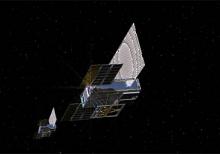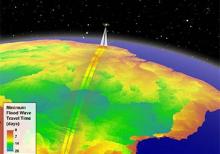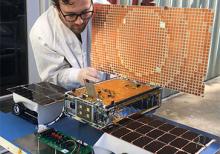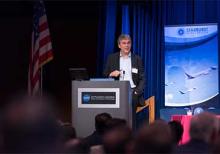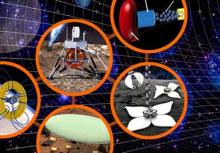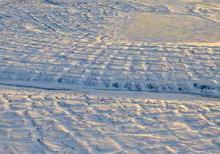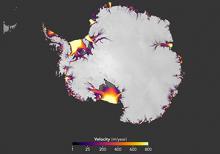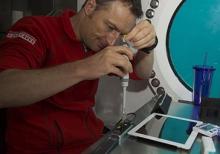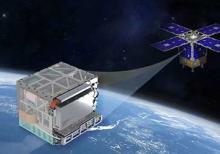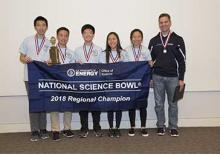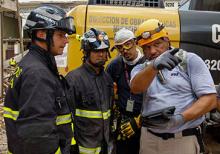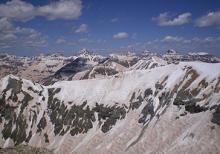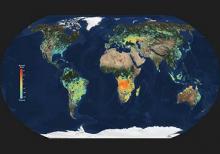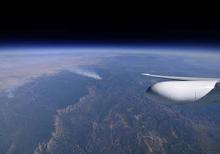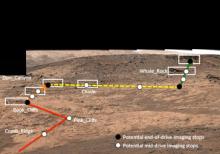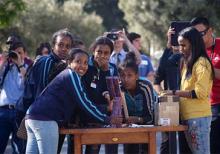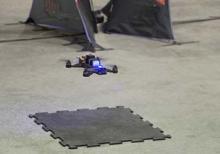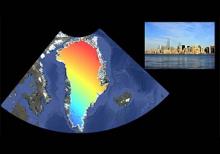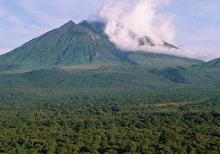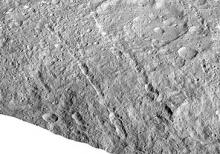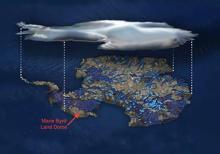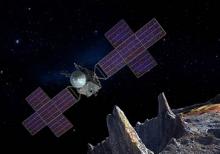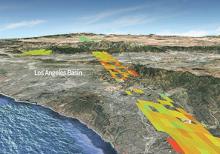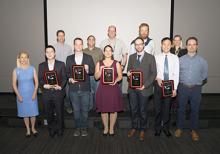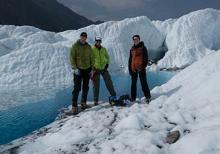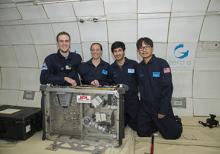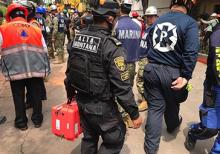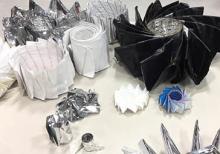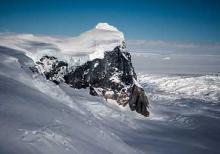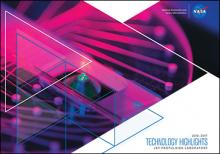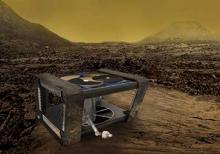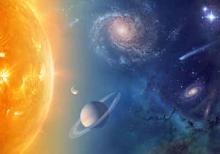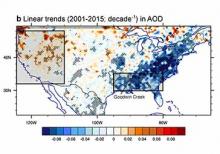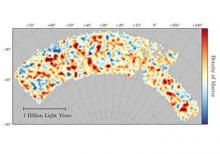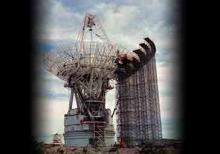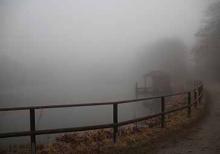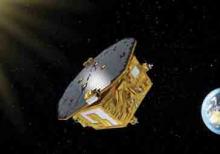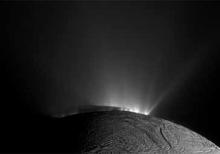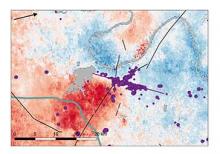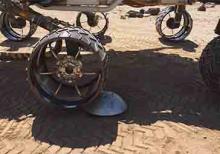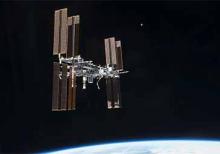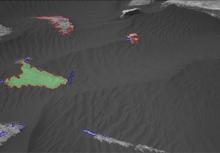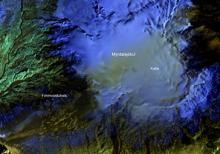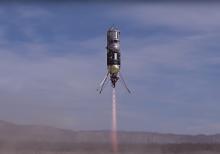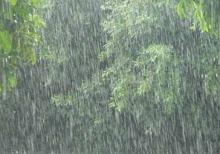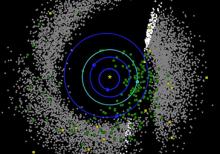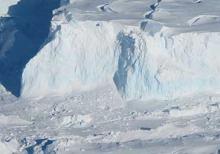The Media Relations Office at JPL is responsible for issuing press releases and hosting media events. As an institution, discussing new discoveries with the public is key to JPL's success as an institution. Below are selected press releases from JPL about new advances in many research fields.
News Board
MarCO is a pair of tiny spacecraft that launched with NASA's InSight lander today.
River floods are one of Earth's most common and devastating natural disasters. A NASA study analyzes how river-observing satellites can better help mitigate their effects.
The first CubeSat mission to deep space will launch in May.
NASA has selected 24 new Fellows for its prestigious NASA Hubble Fellowship Program (NHFP) in 2018.
HOT BIRD Isn't Hot or a Bird. It's the World-Class IR Detector You've Never Heard Of.
Startup companies in the aerospace sector descended on JPL to pitch their ideas to JPL technologists, corporate and government agency leaders, and potential investors.
NASA is investing in technology concepts, including several from JPL, that may one day be used for future space exploration missions.
Permafrost in the far northern Arctic will thaw enough to become a source of carbon to the atmosphere in 40 to 60 years.
A NASA study based on an innovative technique for crunching torrents of satellite data provides the clearest picture yet of changes in Antarctic ice flow into the ocean.
New technology could cut months off the time it takes to study molecular biology on the International Space Station.
JPL project could help spacecraft keep time more efficiently.
Students were quizzed on a variety of science questions this past weekend.
JPL technology to help find disaster survivors under rubble is included in the 2018 edition of NASA's annual Spinoff publication, which features 49 technologies the agency helped create.
The amount of dust on the snowpack, not the warmth of the spring air, controls the pace of spring snowmelt flowing into the Colorado River.
A new calculation of methane emissions from global fires resolves what looked like irreconcilable differences in explaining the recent methane increase.
Scientists have completed flight tests of prototype potential satellite sensors probing basic science questions about aerosols, clouds, air quality and global ocean ecosystems.
JPL’s driverless rovers get another upgrade.
Dr. Shouleh Nikzad was recently elected to the rank of Fellow in the National Academy of Inventors.
Students from as far away as Tanzania and Ethiopia joined JPL professionals in the annual Invention Challenge.
Artificial intelligence could soon match the skills of professional drone pilots.
A new NASA tool that links changes in sea level in 293 global port cities to specific regions of melting land ice may help coastal planners prepare for future rising seas.
The equivalent of up to three-quarters of the carbon stored in contiguous U.S. forests is locked in the living vegetation of one African country, according to new research.
Surface features on Ceres and its interior evolution have a closer relationship than one might think.
A geothermal heat source may help explain why West Antarctica's ice sheet is so unstable.
A spacecraft destined to explore a unique asteroid will also test new communication hardware that uses lasers instead of radio waves.
OCO-2 data are revealing subtle ways that carbon links everything on Earth, as demonstrated by a diverse special collection of research papers in the journal Science.
Winners of the annual 2017 Postdoc Research Day gave seminars on their research and were presented with plaques to commemorate the event.
Cubesat experts are helping to map out icy, underwater caves.
A series of parabolic flights from Zero Gravity Corporation enabled researchers to test and validate the performance of two technologies from JPL.
Disaster relief workers in Mexico City who are responding to a 7.1-magnitude earthquake used a suitcase-sized radar instrument than can detect human heartbeats under rubble.
Origami has taken on new shape at NASA's Jet Propulsion Laboratory.
The flow speeds of Antarctica's fastest-accelerating glaciers in 2008-2014 likely increased because of warm water blown into their bay by La Niña and another climate pattern.
A new document highlights a diverse set of technology developments -- out of numerous similar efforts at JPL -- that are essential for JPL’s continuing contribution to NASA’s future success.
Mechanical computers could help explore an extremely unwelcoming planet.
NASA has selected six astrophysics Explorers Program proposals for concept studies, three of which are managed by JPL.
In the 1900s, the U.S. warmed everywhere except the Southeast, where warming didn't begin till the 1990s. A study finds air quality improvements may have played a role.
Three JPL scientists are part of the Dark Energy Survey, which is helping to further our understanding of the structure of the universe.
Over the mission's 40 years, NASA's Voyager spacecraft have paved the way for modern deep space communications.
What makes clouds drizzle? A new study overturns a common assumption about raindrop size.
The spacecraft was steady as they come. That has big implications for future science.
A new science paper looks at a novel way to detect microbes on another planet.
A NASA-led study examines the geology of last September's magnitude 5.8 earthquake in Pawnee, Oklahoma, the strongest ever measured by instruments in state history.
A new software program reduces wear and tear on the Curiosity Mars rover wheels.
Cleanliness on the International Space Station is a priority.
The software has had a successful first year on NASA's Curiosity rover and is planned for the Mars 2020 mission.
JPL experts outline how autonomy can free robotic explorers to make discoveries.
NASA technology aims for more precise interplanetary landings.
Global climate models may underestimate the amount of rain that will fall in the tropics as our planet continues to warm.
NASA's Near-Earth Object Wide-field Infrared Survey Explorer (NEOWISE) mission has released its third year of survey data of asteroid and comet discoveries.
Thwaites Glacier is melting rapidly but not as fast as earlier research predicted, according to a new NASA study using a more realistic computer model.
MarCO is a pair of tiny spacecraft that launched with NASA's InSight lander today.
River floods are one of Earth's most common and devastating natural disasters. A NASA study analyzes how river-observing satellites can better help mitigate their effects.
The first CubeSat mission to deep space will launch in May.
NASA has selected 24 new Fellows for its prestigious NASA Hubble Fellowship Program (NHFP) in 2018.
HOT BIRD Isn't Hot or a Bird. It's the World-Class IR Detector You've Never Heard Of.
Startup companies in the aerospace sector descended on JPL to pitch their ideas to JPL technologists, corporate and government agency leaders, and potential investors.
NASA is investing in technology concepts, including several from JPL, that may one day be used for future space exploration missions.
Permafrost in the far northern Arctic will thaw enough to become a source of carbon to the atmosphere in 40 to 60 years.
A NASA study based on an innovative technique for crunching torrents of satellite data provides the clearest picture yet of changes in Antarctic ice flow into the ocean.
New technology could cut months off the time it takes to study molecular biology on the International Space Station.
JPL project could help spacecraft keep time more efficiently.
Students were quizzed on a variety of science questions this past weekend.
JPL technology to help find disaster survivors under rubble is included in the 2018 edition of NASA's annual Spinoff publication, which features 49 technologies the agency helped create.
The amount of dust on the snowpack, not the warmth of the spring air, controls the pace of spring snowmelt flowing into the Colorado River.
A new calculation of methane emissions from global fires resolves what looked like irreconcilable differences in explaining the recent methane increase.
Scientists have completed flight tests of prototype potential satellite sensors probing basic science questions about aerosols, clouds, air quality and global ocean ecosystems.
JPL’s driverless rovers get another upgrade.
Dr. Shouleh Nikzad was recently elected to the rank of Fellow in the National Academy of Inventors.
Students from as far away as Tanzania and Ethiopia joined JPL professionals in the annual Invention Challenge.
Artificial intelligence could soon match the skills of professional drone pilots.
A new NASA tool that links changes in sea level in 293 global port cities to specific regions of melting land ice may help coastal planners prepare for future rising seas.
The equivalent of up to three-quarters of the carbon stored in contiguous U.S. forests is locked in the living vegetation of one African country, according to new research.
Surface features on Ceres and its interior evolution have a closer relationship than one might think.
A geothermal heat source may help explain why West Antarctica's ice sheet is so unstable.
A spacecraft destined to explore a unique asteroid will also test new communication hardware that uses lasers instead of radio waves.
OCO-2 data are revealing subtle ways that carbon links everything on Earth, as demonstrated by a diverse special collection of research papers in the journal Science.
Winners of the annual 2017 Postdoc Research Day gave seminars on their research and were presented with plaques to commemorate the event.
Cubesat experts are helping to map out icy, underwater caves.
A series of parabolic flights from Zero Gravity Corporation enabled researchers to test and validate the performance of two technologies from JPL.
Disaster relief workers in Mexico City who are responding to a 7.1-magnitude earthquake used a suitcase-sized radar instrument than can detect human heartbeats under rubble.
Origami has taken on new shape at NASA's Jet Propulsion Laboratory.
The flow speeds of Antarctica's fastest-accelerating glaciers in 2008-2014 likely increased because of warm water blown into their bay by La Niña and another climate pattern.
A new document highlights a diverse set of technology developments -- out of numerous similar efforts at JPL -- that are essential for JPL’s continuing contribution to NASA’s future success.
Mechanical computers could help explore an extremely unwelcoming planet.
NASA has selected six astrophysics Explorers Program proposals for concept studies, three of which are managed by JPL.
In the 1900s, the U.S. warmed everywhere except the Southeast, where warming didn't begin till the 1990s. A study finds air quality improvements may have played a role.
Three JPL scientists are part of the Dark Energy Survey, which is helping to further our understanding of the structure of the universe.
Over the mission's 40 years, NASA's Voyager spacecraft have paved the way for modern deep space communications.
What makes clouds drizzle? A new study overturns a common assumption about raindrop size.
The spacecraft was steady as they come. That has big implications for future science.
A new science paper looks at a novel way to detect microbes on another planet.
A NASA-led study examines the geology of last September's magnitude 5.8 earthquake in Pawnee, Oklahoma, the strongest ever measured by instruments in state history.
A new software program reduces wear and tear on the Curiosity Mars rover wheels.
Cleanliness on the International Space Station is a priority.
The software has had a successful first year on NASA's Curiosity rover and is planned for the Mars 2020 mission.
JPL experts outline how autonomy can free robotic explorers to make discoveries.
NASA technology aims for more precise interplanetary landings.
Global climate models may underestimate the amount of rain that will fall in the tropics as our planet continues to warm.
NASA's Near-Earth Object Wide-field Infrared Survey Explorer (NEOWISE) mission has released its third year of survey data of asteroid and comet discoveries.
Thwaites Glacier is melting rapidly but not as fast as earlier research predicted, according to a new NASA study using a more realistic computer model.
